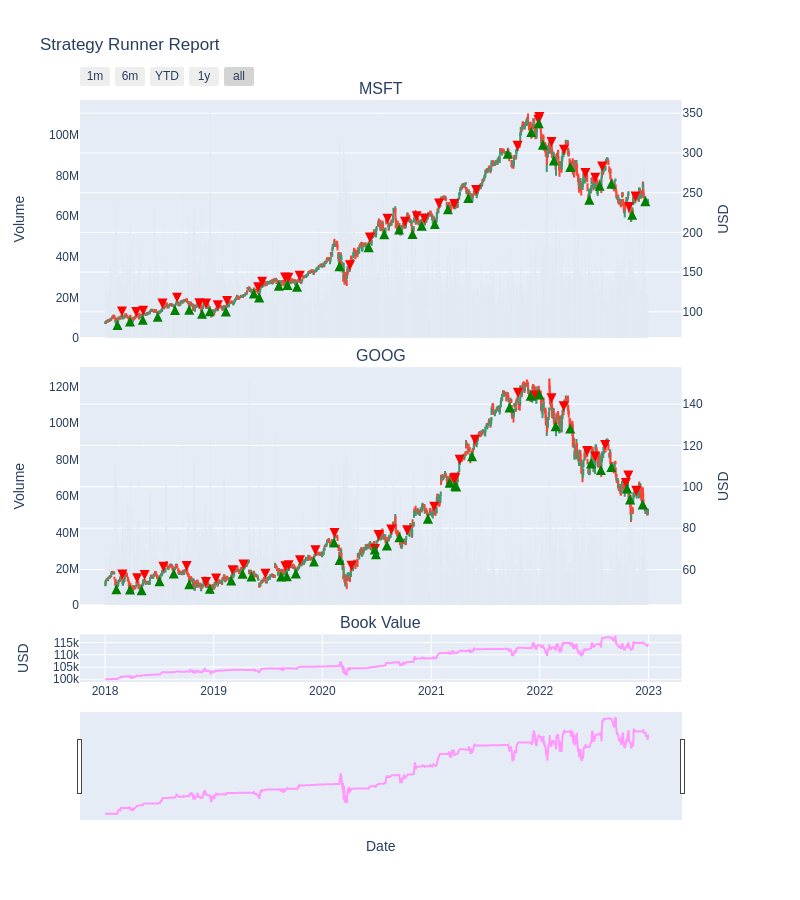Python module for backtesting trading strategies.
Features
- Event driven, ie
on_open,on_close, etc. - Multiple assets.
- OHLC Asset. Extendable (e.g support additional fields, e.g. Volatility, or entirely different fields, e.g. Barrels per day).
- Multiple books.
- Positional and Basket orders. Extendible (e.g. can support stop loss).
- Batch runs (for optimization).
- Captures book history including transactions & daily cash, MtM and total values.
The module provides basic statistics like book cash, mtm and total value. Currently, everything else needs to be deferred to a 3rd party module like empyrical.
The core module uses pandas and scipy.
pip install yatbeBelow is an example usage (the economic performance of the example strategy won't be good).
import pandas as pd
from yabte.backtest import Book, SimpleOrder, Strategy, StrategyRunner
from yabte.tests._helpers import generate_nasdaq_dataset
from yabte.utilities.plot.plotly.strategy_runner import plot_strategy_runner_result
from yabte.utilities.strategy_helpers import crossover
class SMAXO(Strategy):
def init(self):
# enhance data with simple moving averages
p = self.params
days_short = p.get("days_short", 10)
days_long = p.get("days_long", 20)
close_sma_short = (
self.data.loc[:, (slice(None), "Close")]
.rolling(days_short)
.mean()
.rename({"Close": "CloseSMAShort"}, axis=1, level=1)
)
close_sma_long = (
self.data.loc[:, (slice(None), "Close")]
.rolling(days_long)
.mean()
.rename({"Close": "CloseSMALong"}, axis=1, level=1)
)
self.data = pd.concat(
[self.data, close_sma_short, close_sma_long], axis=1
).sort_index(axis=1)
def on_close(self):
# create some orders
for symbol in ["GOOG", "MSFT"]:
df = self.data[symbol]
ix_2d = df.index[-2:]
data = df.loc[ix_2d, ("CloseSMAShort", "CloseSMALong")].dropna()
if len(data) == 2:
if crossover(data.CloseSMAShort, data.CloseSMALong):
self.orders.append(SimpleOrder(asset_name=symbol, size=-100))
elif crossover(data.CloseSMALong, data.CloseSMAShort):
self.orders.append(SimpleOrder(asset_name=symbol, size=100))
# load some data
assets, df_combined = generate_nasdaq_dataset()
# create a book with 100000 cash
book = Book(name="Main", cash="100000")
# run our strategy
sr = StrategyRunner(
data=df_combined,
assets=assets,
strategies=[SMAXO()],
books=[book],
)
srr = sr.run()
# see the trades or book history
th = srr.transaction_history
bch = srr.book_history.loc[:, (slice(None), "cash")]
# plot the trades against book value
plot_strategy_runner_result(srr, sr)Jupyter notebook examples can be found under the notebooks folder.
Documentation can be found on Read the Docs.
Before commit run following format commands in project folder:
poetry run black .
poetry run isort . --profile black
poetry run docformatter . --recursive --in-place --black --exclude _unittest_numpy_extensions.py